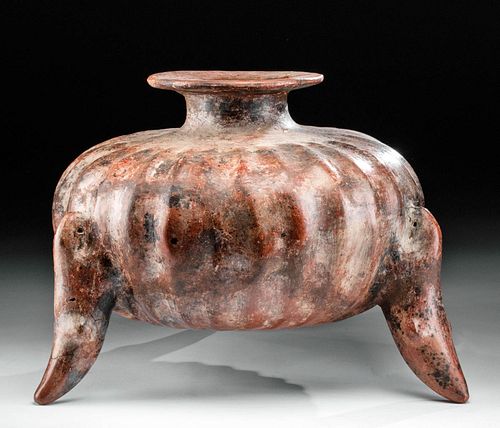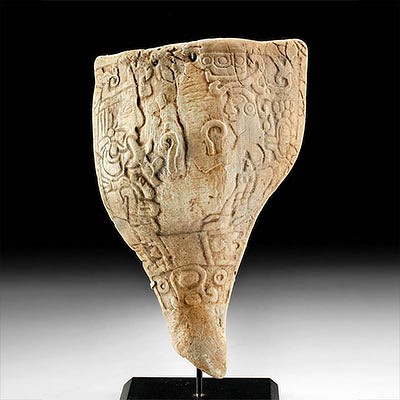Colima Pottery Parrot Tripod Vessel
Lot 53
About Seller
Artemis Fine Arts
686 S Taylor Ave, Ste 106
Louisville, CO 80027
United States
Selling antiquities, ancient and ethnographic art online since 1993, Artemis Gallery specializes in Classical Antiquities (Egyptian, Greek, Roman, Near Eastern), Asian, Pre-Columbian, African / Tribal / Oceanographic art. Our extensive inventory includes pottery, stone, metal, wood, glass and textil...Read more
Categories
Estimate:
$2,000 - $3,000
Absentee vs Live bid
Two ways to bid:
- Leave a max absentee bid and the platform will bid on your behalf up to your maximum bid during the live auction.
- Bid live during the auction and your bids will be submitted real-time to the auctioneer.
Bid Increments
| Price | Bid Increment |
|---|---|
| $0 | $25 |
| $300 | $50 |
| $1,000 | $100 |
| $2,000 | $250 |
| $5,000 | $500 |
| $10,000 | $1,000 |
| $20,000 | $2,500 |
| $50,000 | $5,000 |
| $100,000 | $10,000 |
| $200,000 | $20,000 |
About Auction
By Artemis Fine Arts
Oct 15, 2020
Set Reminder
2020-10-15 12:00:00
2020-10-15 12:00:00
America/New_York
Bidsquare
Bidsquare : Art of the Americas - Ancient to Present
https://www.bidsquare.com/auctions/artemis-gallery/art-of-the-americas---ancient-to-present-5840
Ancient and ethnographic art from cultures encompassing the Americas - Pre-Columbian, Native American, Northwest Coast, Spanish Colonial, more. All legally acquired, all legal to sell, all guaranteed to be as described or your money back. Convenient in-house shipping! Artemis Fine Arts info@artemisgallery.com
Ancient and ethnographic art from cultures encompassing the Americas - Pre-Columbian, Native American, Northwest Coast, Spanish Colonial, more. All legally acquired, all legal to sell, all guaranteed to be as described or your money back. Convenient in-house shipping! Artemis Fine Arts info@artemisgallery.com
- Lot Description
Pre-Columbian, West Mexico, Colima, ca. 100 BCE to 250 CE. This Colima redware vessel assumes the form of a wide, voluminous squash with a gadrooned body that is stylistically segmented by meticulously delineated vertical ribbing, features a boldly flaring spout, and is supported by three legs assuming the form of parrots, birds prized for their feathers among the ancients of America. Each avian form is defined with incised and pierced ovoid eyes, curved beaks, and modeled wings upon a plump body that resolves to a tapered tail. Interestingly, art imitates life in this ceramic vessel, as the indigenous of Mexico used hollowed gourds for storing and serving food and drink. Furthermore, iconographically this piece is quite poignant as squashes and parrots were both symbols of fertility and abundance. Size: 11.75" W x 10.45" H (29.8 cm x 26.5 cm)
In the Pre-Columbian world, birds were highly symbolic and favorite iconographical subjects in art. As sky animals, they were associated with the celestial sun and moon and were believed to act as messengers between humankind and their deities. Parrots were and continue to be revered by the ancients of the Americas. Their brilliant plumage and ability to fly high above the tree-line made them ideal incarnations of the sky deities, thought to be endowed with supernatural powers of celestial origin.
Provenance: ex-private collection of the late Father Bader, University of St. Thomas, Houston, Texas, USA, acquired prior to 2000
All items legal to buy/sell under U.S. Statute covering cultural patrimony Code 2600, CHAPTER 14, and are guaranteed to be as described or your money back.
A Certificate of Authenticity will accompany all winning bids.
We ship worldwide and handle all shipping in-house for your convenience.
#154258Repaired and restored from multiple pieces. Losses on the rim around repairs as shown. Legs are also repaired. The restoration, which is mainly on the shoulder, is well done and unobtrusive.Condition
- Shipping Info
-
All shipping is handled in-house for your convenience. Your invoice from Artemis Gallery will include shipping calculation instructions. If in doubt, please inquire BEFORE bidding for estimated shipping costs for individual items.
-
- Buyer's Premium



 EUR
EUR CAD
CAD AUD
AUD GBP
GBP MXN
MXN HKD
HKD CNY
CNY MYR
MYR SEK
SEK SGD
SGD CHF
CHF THB
THB
















